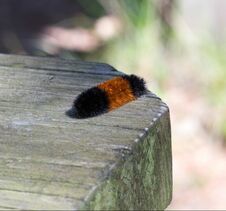 The woolly bear caterpillar (aka fuzzy and woolly worm) has the reputation of being capable of forecasting the upcoming winter weather. Regardless if this is folklore or fact, learn some insight into the woolly bear caterpillar and how to interpret the worm. Here’s the tale: The Woolly Bear caterpillar has 13 separate segments of either black or rusty brown. The bigger the rusty brown sections (or, the browner the parts are), the milder the upcoming winter will be. The blacker it is, the harsher the winter. A woolly bear caterpillar is a form of the tiger moth (Isabella). This mid-size moth, with yellow-orange and cream-colored wings dotted with black, is familiar from northern Mexico throughout the US and across the southern part of Canada. As moths are concerned, the woolly bear caterpillar isn’t great to look at matched with other types, but its young larva, known as the black-ended and woolly bear is one of the few caterpillars most folks can identify. Woolly bears don’t feel much like wool. They are covered with stiff, short bristles of hair. Do they forecast the winter? Between 1948 and 1956, a medical professional, Dr. Curran, counted an average brown-segment ranged between 5.3 to 5.6 from the 13-segment total, signifying that the brown band took up over a third of the woolly bear’s body. The following winters were milder than usual, and Dr. Curran decided that the folklore might be real. But Curran was under no scientific illusion. He understood that his data samples were minute. Although the tests legitimized folklore to some, they were just a reason to have fun. Thirty years after Curran’s experiment, the woolly bear brown-segment tally and winter forecasts were revived thanks to the nature museum at Bear Mountain State Park. The annual counts have continued, often by word of mouth. If the rusty band is full, then it will be a mild winter. The blacker there is, the harsher the winter. If you find any other insect in your tree, ask a knowledgeable tree specialist to check it out for you. Comments are closed.
|
AuthorWe at Syracuse Tree Service want to help you with your tree service needs, our blog is where we provide helpful tips and ideas for the health of your trees. Archives
December 2020
Categories
All
|
- Home
- Services
- About
- Contact
-
Service Locations
- Liverpool Tree Service
- North Syracuse Tree Service
- Cicero Tree Service
- Baldwinsville Tree Service
- Manlius Tree Service
- Weedsport Tree Service
- Clay Tree Service
- Bridgeport Tree Service
- Lafayette Tree Service
- Fayetteville Tree Service
- Chittenango Tree Service
- Camillus Tree Service
- Onondaga Tree Service
- East Syracuse Tree Service
- Blog
|
Home | Services | About Us | Contact Us
Liverpool | North Syracuse | Cicero | Baldwinsville | Manilus | Weedsport | Clay | Bridgeport | Lafayette | Fayetteville | Chittenango | Camillus | Onondaga | East Syracuse © Syracuse Tree Care 2017
Syracuse Tree Care 4736 Onondaga Blvd Suite 112 Syracuse, NY 13219 (315) 692-0186 |
|

 RSS Feed
RSS Feed